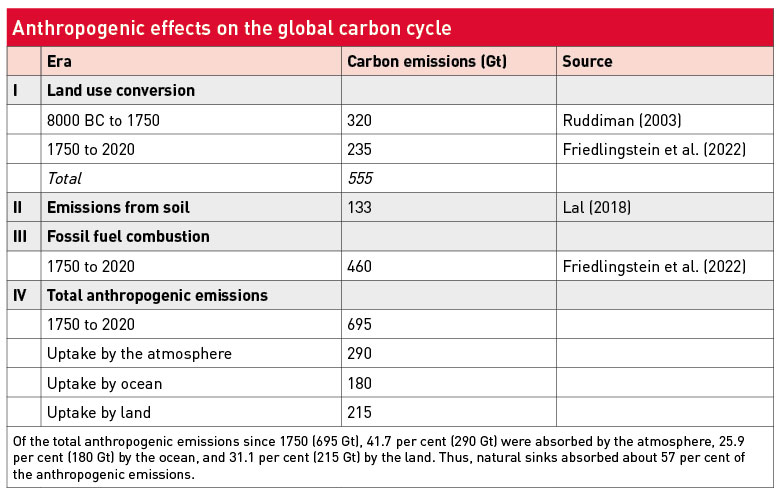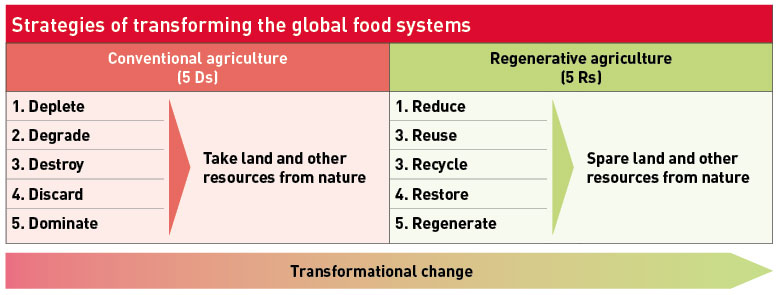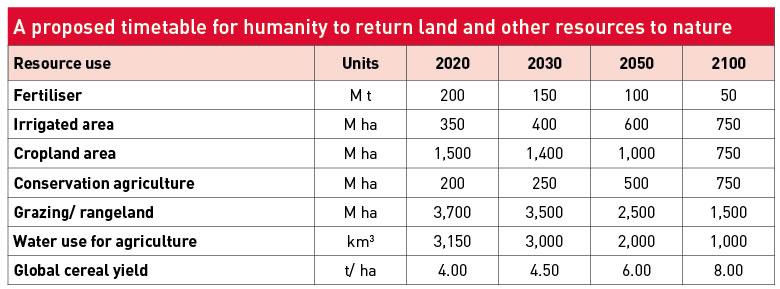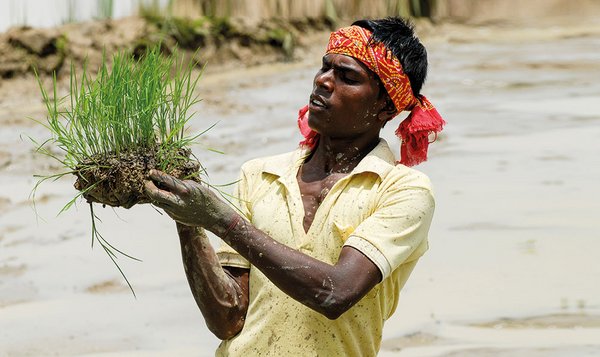 Download this article in magazine layout
Download this article in magazine layout
- Share this article
- Subscribe to our newsletter
Returning land to nature
One third of all soils of the world are degraded. Given its drastic effects on water, energy and biogeochemical cycles, anthropogenic soil degradation must be recognised in the planetary boundaries framework proposed by Rockström and colleagues in 2009. Aggravation of soil degradation may weaken critical ecosystem services and even create disservices. It is also important to understand that the severe and global problem of soil degradation is driven by land misuse and soil mismanagement. The prevalence and perpetuation of conventional agricultural practices accelerate degradation processes such as depletion of soil organic carbon (SOC), decline of soil structure, acceleration of soil erosion, increase in risks of salinisation, and decline in activity and diversity of soil biota (see also article "Soil organisms for healthy soil and sustainable agriculture"). Such a downward spiral must be stopped and reversed through innovation in agricultural practices, so that agriculture is a solution rather than a major problem of environmental degradation.
Why we need a paradigm shift
Conversion of natural to agroecosystems has been a major source of increase in atmospheric concentration of carbon dioxide (CO2) ever since the dawn of settled agriculture. In all, land use, land use change and agriculture may have emitted a total of 555 gigatonnes (Gt) of carbon into the atmosphere since the beginning of agriculture about ten millennia ago (see Table below). Agroecosystems may have lost as much as 133 Gt of soil organic carbon, with adverse impacts on soil health and functionality and aggravation of the anthropogenic global warming. As Yang and Tan stated in 2021, global consumption of agricultural and forestry commodities, excluding wood fuel, resulted in the loss of 15.6 Gt of land C annually, of which 29 per cent and 25 per cent were attributed to beef and wood consumption, respectively.

Although it is obvious that present food systems have failed to end hunger and malnutrition and haven’t provided nutritious/ healthy and safe food – the latter being a prerequisite for reaching the UN’s Sustainable Development Goal (SDG) 2 – the prevalence of hunger and hidden hunger is still being used as an excuse for deforestation and conversion of natural to agroecosystems, drastic soil disturbance and excessive ploughing, indiscriminate use of agro-chemicals and expansion of flood-based irrigation in conjunction with monoculture systems.
The health of soil, plants, animals, people, ecosystems and planetary processes is one and indivisible.
Such systems are degrading soil health, diminishing biodiversity, declining agronomic productivity, reducing use efficiency of inputs and increasing rural poverty. Thus, there is a need for a paradigm shift towards sustainable agricultural systems which restore rather than degrade soil health, mitigate and adapt to rather than aggravate climate change, promote negative emission farming rather than being a source of greenhouse gases (GHGs), make land a major sink rather than a source of atmospheric C stock, and return some land to nature rather than expand land area under agroecosystems. Therefore, innovative agroecosystems are needed which can lead to re-carbonisation of the terrestrial biosphere (soil and vegetation) as the bedrock of sustainable development. Simply put, agriculture must restore degraded soils and improve the environment while strengthening the ecosystem services essential for human wellbeing and nature conservancy. Such is the premise of so-called regenerative agriculture, which may be a clarion call and a solution towards achieving sustainable food systems.
Producing more from less with regenerative agriculture
Regenerative agriculture (RA) is an integration of two contrasting approaches – agroecology and sustainable intensification – under the same banner. In other words, it is a biometric technology, based on the concept of producing more from less. It is not to be confused with no-input agriculture. In fact, the concept is based on the Law of Return which states that “substances we take from nature must be returned to the same place from which they were taken”. The strategy is to create a positive soil/ ecosystem carbon budget so that the terrestrial C stock (soil and vegetation) is restored and is always on an increasing trend. Because of the coupled cycling of C with other elements (nitrogen, phosphorus, sulphur), the overall soil fertility must be restored through inputs (recycling) of biomass-C along with strengthening of biological nitrogen fixation.
At the core of RA are the goals to restore soil organic matter (SOM) content, enhance new soil formation and set in motion the nature-positive trend, including adaptation to and mitigation of climate change and alleviation of the recurrent drought-flood syndrome. By re-carbonisation of soils via photosynthesis, and by practices which take cues from nature and biology, RA can sequester atmospheric C and thus is an effective climate responsible option.
Regenerative agriculture comprises site-specific nature-positive agricultural practices which restore functions of degraded/ depleted soils and improve environment quality. It is specifically designed to harness the power of the food-energy-water-soil (FEWS) nexus. According to Rhodes (2017), the specific goal of adopting RA is to improve soil health, and through it, enhance the quality of water, air, biodiversity and productivity of agroecosystems. The overall strategy is to replace the current “take, make, dispose waste creation” model by a “reduce, reuse, recycle, regenerate” approach (see Figure below). Being a “one size fits none” approach, a wide range of practices (e.g. cover cropping, agroecology) and outcomes (e.g. improvement of soil health, C sequestration, increase in biodiversity, or combination of both) can be grouped under RA. System-based conservation agriculture (CA) – practised globally on roughly 200 million hectares (M ha) – and integration of crops with trees and livestock are among RA practices. Permaculture, circular economy, sustainable livestock rearing and urban agriculture are also integral to RA. 
Scientific evidence for benefits of regenerative agriculture
Soil quality indicators under regenerative agriculture have been developed to assess impacts on ecosystem services in general. However, specific effects of RA on soil organic matter content and soil organic carbon stocks need to be quantified in relation to climate action. Jordon and colleagues (2022), for example, used the Rothamsted Carbon (Roth C) Model to assess the impacts of three RA practices on SOC stocks: cover cropping, reduced tillage and grass-based ley rotations. They found that cover cropping increased SOC stock at the rate of 10 tons of carbon/hectare (t C/ha) within 30 years of adoption across Great Britain. SOC stocks were increased by 3 to 16 t C/ha for ley-arable systems depending on the length of the ley-phase, but little change in SOC stocks was observed under reduced tillage systems.
De Otalora and colleagues (2021) observed that regenerative rotational grazing of dairy sheep achieved 30 per cent higher topsoil C storage and soil ecosystem services than conventional grazing. Kleppel (2020) assessed the importance of herbivore-carnivore interactions in relation to grassland ecosystem functionality and human nutrition and observed that regenerative-multi-paddock (RM) management may reduce blue water withdrawals and greenhouse gas (GHG) emissions by 75 per cent relative to industrial conventional management. Kleppel also observed that a significant amount of anthropogenic CO2eq emissions can be removed from the atmosphere and sequestered in soil by RM management services. Horton and colleagues (2021) reported that RA practices used in conjunction with silicate amendment of soils to sequester atmospheric CO2 increased SOC stocks and yield and improved C storage. These practices include less intensive RA, afforestation, bioenergy crops, etc.
Humans cultivate about 150 of an estimated 30,000 edible plant species globally, and most diets comprise only 30 plant species in all. Therefore, commercial uses of new crops and wild plants of local origin can help diversify local food systems, and improve adaptation to diverse environments humans live in. It is argued that conventional agricultural practices are stripping essential nutrients from food and polluting it with chemicals and increasing risks of modern diseases. Several studies have documented improvements in the nutritional profile of crops and livestock raised with RA to address human health challenges. Montgomery and colleagues (2022), for example, reported that wheat crops in northern Oregon had a higher density of mineral micronutrients in the crops grown by RA practices than that in conventionally grown crops. They also found higher levels of omega-3 fats and a more health-beneficial ratio of omega-6 to omega-3 fats in beef and pork raised under RA. These beneficial impacts on micronutrient and phytochemical concentrations under RA could help in chronic disease prevention.
Returning resources to nature
Giving some land back to nature is an important criterion of regenerative agriculture. For the five billion (B) hectares of land under agriculture (1.5 B ha under cropland and 3.73 B ha under grazing/ rangeland), there must be a well thought of agenda to return some land to nature (see Table below). The overall goal is to renaturalise 0.75 B ha of cropland and 2 B ha of grazing land by 2100. However, other resources also ought to be given back to nature or at least saved on. Improving fertiliser and irrigation water use efficiency would lead to a drastic reduction in the consumption of both while increasing the global average cereal yield. To achieve the goal of improving the use efficiency of fertiliser, emphasis must be on carbon, nitrogen, phosphorous and potassium (CPNK), rather than just NPK, so that an increase in soil C stock can reduce over time the use of chemical fertilisers.

Furthermore, improvement in soil health would create disease-suppressive soils and reduce the need for pesticide use. Integration of crops with trees (and livestock) would increase the forest cover on agroecosystems and enhance the terrestrial C stock. Change of flood-based or sprinkler system of irrigation to drip sub-fertigation may increase the land area equipped for irrigation and yet decrease the total water use for agriculture.
Reducing livestock is key
It is widely believed that global average crop yields could be more than doubled through the adoption of proven agricultural practices. This strategy would allow the reduction of cropland area by nearly 50 per cent of its current extent. Reportedly, 25 per cent of the global land surface is used as grazing land for raising livestock. Livestock grazing removes a large quantity of C from global rangeland. Globally, 35 per cent of all primary crop harvests and 24 per cent of all crop residues are consumed by livestock. In addition to these fodder sources, global livestock currently grazes on roughly 25 per cent of all ice-free land area, compared to only two per cent before the onset of industrial revolution.
Presently, global biomass of mammalian livestock is 67 per cent greater than that of humans, 1,329 per cent larger than of all wild mammals, and 318 per cent larger than total mammalian biomass that was supported by the Earth 100,000 years ago. Therefore, an objective evaluation of grazing land and sparing some of it for nature by reducing the livestock population (through changes in human diet) is critical for humans to live in harmony with nature.
Drivers of change for translating science into action
Global upscaling of RA practices requires an understanding of what motivates land managers to adopt them. Based on a study in New South Wales, Australia, Gosnell (2022) concluded that, along with positive experiences with the microbiome, negative experiences with agrochemicals in combination with increasing costs and declining results were important motivations to bring about the desired transformation towards upscaling of RA practices. Policy interventions for incentivising farmers through payments for ecosystem services is another option. The technical potential of organic carbon sequestration in soils across the world is put at about 2.5 Gt C per year or 25 per cent of the C emissions from fossil fuel combustion. The cumulative potential of C sequestration in soil and vegetation between 2020 and 2100 is estimated at 333 Gt C or drawdown of atmospheric CO2 by roughly 157 ppm. However, to exploit it, payments must be provided at a societal value of C estimated at about 120–125 US dollars per t C to promote C-farming. In this context, the role of the private sector in translating science into action cannot be over-emphasised. Education about healthy diets and the use of plant-based protein may be a further important strategy to reduce land area under grazing as well as enteric emission of methane (also see Box). Reducing food waste, by improving the shelf life and storage facilities, is among important strategies to sparing land for nature. Promoting soil-less culture in conjunction with urban farming and home gardening is a pertinent option to promote RA and spare land. There is no shortage of food or capacity to produce enough food to adequately feed the current and foreseeable population globally.
Rattan Lal is Director of the CFAES Rattan Lal Center for Carbon Management and Sequestration, and Distinguished University Professor of Soil Sciences at Ohio State University, Columbus, USA. He was awarded the 2020 World Food Prize for developing and mainstreaming a soil-centric approach to increasing food production restoring and conserving natural resources and mitigating climate change.
Contact: lal.1(at)osu.edu
References
Andersen, M.D., Rivera-Ferre, M. 2021. Food systems narratives to end hunger: extractive versus regenerative. Current Opinion in Environmental Sustainability 49: 18-25. doi:10.1016/j.cosust.2020.12.002.
Anderson, S. 2019. One Size Fits None: A Farm Girl’s Search for the Promise of Regenerative Agriculture. ISBN: 978-1-4962-0505-6, 296 pp.
Barrera, E.L and T. Hertel 2020. Global food waste across the income spectrum: implications for food prices, production and resource use. Food Policy, 101874.
Brown, K. et al., 2021. Regenerative farming and human wellbeing: Are subjective wellbeing measures useful indications for sustainable family systems? Environmental and Sustainability Indications II, Article # 100132, https://doi.org/10.1016/j.indic.2021.100132.
De Otalora, X. D., Epelde, L., Arranaz, J., Garbisu, C., Ruiz, R., Mandaluniz, N. 2021. Regenerative rotational grazing management of dairy sheep increases springtime grass production and topsoil carbon storage. Ecological Indicators 125, Article # 107484, https://doi.org/10.1016/j.ecolind.2021.107484.
DeLonge, M. and A. Basche 2017. Managing grazing lands to improve soils and promote climate change adaptation and mitigation:a global synthesis. Renewable Agriculture and Food Systems.33(3):267-278.
Delonge, M. S. et al. 2016. Investing in transition to sustainable agriculture. Env. Sci & Policy. 55: 266-273. https://doi.org/10.1016/j.envsci.2015.09.013.
Fanzo, J. 2019. Healthy and sustainable diet and food systems: The key to Sustainable Development Goal 2? Food Ethics 4:159-174.
FAO and ITPS 2015.Status of World Soil Resources: Main Report: Food and Agriculture Organization of the United Nations and Intergovernment Technical Panel on Soils ,Rome,Italy,. http://www.fao.org/3/a-i5199e.pdf
Feniuk, C., A. Balmford and R. E. Green 2019. Land sparing to make space for species dependent on natural habitats and high nature value farmland. Proc. Royal Society (B),28 August 2019, https:// doi.org/10.1098/rspb.2019/1483.
Folberth, C., N.Khabarov, J. Balkovic, R. Skalsky, P. Visconti et al. 2020. The global cropland sparing potential of high-yield farming. Nature Sustainability 3: 281-289.
Friedlingstein, P., Jones, M. W., O’Sullivan, M., Andrew, R. M., Bakker, D. C. E. et al. 2022. Global carbon budget 2021. Earth Science Data 14: 1917-2005.
Giller, K. E., Hijbeek, R. Andersson, J. Sumberg, J. 2021. Regenerative Agriculture: An agronomic perspective. Outlook on Agriculture. https://doi.org/10.1177/0030727021998063. 50(1): 13-25.
Gosnell, H. 2022. Regenerating soil, regenerating soil: an integral approach to understanding transformation. Sustainability Science 17(2):603-620.
Gremman, B. 2022. Regenerative agriculture as a biomimetic technology. Outlook on Agriculture. https://doi.org/10.1177/00307270211070317. 51(1): 39-45.
Horton, P., Long, S. L., Smith, P., Banwart, S.A., Beerling, D.J. 2021. Technologies to deliver food and climate security through agriculture. Nature Plants 7(3):250-255.
Howard, Sir Albert. 1943. An Agricultural Testament,Oxford University Press,U.K.
IPCC 2019. Climate Change and Land. Intergovernmental Panel on Climate Change. www.ipcc.ch/site/assets/uploads/2019/08/4.
Kleppel, G. S. 2020. Do Differences in Livestock Management Practices Influence Environmental Impacts? Patterns in Sustainable Food Systems 4, Article # 141, doi:10.3389/fsufs.2020.00141
Kraamwinkel, C. T., A. Beaulieu, T. Dias and R. A. Howlson 2021. Planetary limits to soil degradation. Communications Earth and Environment 2,Article Number 249(2021).
Lal, R. 2004. Soil carbon sequestration impacts on global climate change and food security. Science 304: 1623-1627. (www.sciencemag.org/cgi/content/full/305/5690/1567DCI).
Lal, R. 2014. Societal value of soil carbon. Journal of Soil and Water Conservation 69: 186A-192A.
Lal, R. 2015. Research and Development Priorities in Water Security.Agronomy Journal 107(4):1567-1572.
Lal, R. 2020a. Home gardening and urban agriculture for advancing food and nutritional security in response to the COVID-19 pandemic. Food Security. https://doi.org/10.1007/s12571-020-01058-3.
Lal, R. 2020b. Integrating Animal Husbandry with Crops and Trees. Frontiers in Sustainable Food Systems 4: 113. www.frontiersin.org/article/10.3389/fsufs.2020.00113.
Lal, R. 2020c. Regenerative agriculture for food and climate. J. Soil Water Conservation Aug 2020. DOI: 10.2489/jswc.2020.0620A.
Lal, R. 2020d. The Role of Industry and the Private Sector in Promoting the 4 Per Thousand Initiative. Geoderma. 378 (15 November): 114613,https://doi.org/10.1016/j.geoderma.2020.114613
Lal, R 2020e. Home gardening and urban agriculture for advancing food and nutritional security in response to COVID 19 pandemic. Food Security, https:// doi.org/10.1007/s12571-020-01058-3.
Lal, R. 2020f (Ed). The Soil -Human Health Nexus . Taylor and Francis, Boca Raton,Fl, 335pp, ISBN:978-0-367-42214-1 (hbk).
Lal, R. 2021. Negative Emission Farming. Journal of Soil and Water Conservation 76, no. 3 (May 1): 61A LP-64A. http://www.jswconline.org/content/76/3/61A.abstract.
Lal, R., R. H. Mohtar, A. T. Assi, R. Ray, H. Baybil, M. Jahn. 2017. Soil as a basic nexus tool: soils at the center of the food-energy-water nexus. Current Sustainable/Renewable Energy Reports 4:117-129.
Lal, R., Smith, P., Jungkunst, J., Mitsch, W., Lehmann, J., et al. 2018. The carbon sequestration potential of terrestrial ecosystems. J.Soil Water Conservation 73:145 A-152A.
Landers, J. N., de Freitas, P. L., de Oliveira, M. C., de Silva Neto, S. P., Ralisch, R. et al., 2021. Next steps for conservation agriculture. Agronomy-based 11(12) article # 2496. Doi:10-3390/agronomy11122496. Pub Dec2021.
Massey, C. 2021. Agriculture, the Anthropocene and human health. J. of Pediatrics and Child Health. 57(11);1819-1825. https://doi.org/10.1111/jpc.15683.
Montanarella, L., Pennock, D. J., McKenzie, N., Badaroui, M., Chude, V. et al. 2016. World soils are under threat. SOIL 2:79-82. https://doi.org/10.5194/soil-2-79-2016.
Montgomery, D. R., Bikle, A., Archuleta, R., Brown, P., and Jordan, J. 2022. Soil Health and nutrient density: preliminary comparison of regenerative and conventional farming. PEERJ 10, Article # e12848. Doi:10.7717/peerj:12848. Pub 27Jan2022.
Pearson, C. J. 2007. Regenerative. Semi-closed systems: A Priority for 21st Century agriculture. BioScience. 57(5): 409-418.
Rhodes, C. J. 2017. The imperative of regenerative agriculture. Science Progress. 100(1):80-129.
Rockstrom, J., Steffen, W., Noone, K., Persson, A., Chapin III, F.S., et al. 2009. A safe operating space for humanity. Nature 461;472-475.
Ruddiman, W. F. 2003. The anthropogenic greenhouse gas era began thousands of years ago. Climatic Change 61:261-293.
Schreefel, L., Schlute, R. P. O, de Boer, I. J. M., van Zanten, H. H. E. 2020. Regenerative agriculture: the soil is the base. Global food security- Agriculture. Policy, Economics, and Environment Vol 26, Article # 100404. https://doi.org/10.1016/j.gfs.2020.100404.
Schulte, L. A., Dale, B. E., Bozzetto, S., Liebman, M., Souza, G. M. et al.Meeting global challenges with regenerative agriculture producing food and energy.Nat Sustain (2021). doi:10.1038/s41893-021-00827-y
Shelef, I., Weisberg, P. J., Provenza, F. D., 2017. The value of native plants and local production in an era of global agriculture frontiers in Plant Sci. Frontiers in Plant Science. National Library of Med. 8, Article # 2069. doi: 10.3389/fpls.2017.02069. Pub 5Dec2017.
Soto, R. L., Padilla, M. C. Vente, J. 2020. Participatory selection of soil quality indications for monitoring the impacts of regenerative agriculture on ecosystem services. Ecosystem services 45, Article # 101157. https://doi.org/10.1016/j.ecoser.2020.101157. Pub OCT 2020.
Sumberg, J. 2022. Future Agricultures: The Promise and Pitfall of a (re)turn to Nature. Outlook on Agriculture 51(1): 3-10. doi:10.1177/00307270221078027.
Tansey, G. 2013. Food and thriving people: paradigm shifts for fair and sustainable food systems. Food and Energy Security 2(1):1-11.
White, C. 2020. Why regenerative agriculture? Am. J. Economics and Sociology. 79(3): 799-812.
Wolf, J., M. Chen and G. A. Asrar 2021. Global rangeland primary production and its consumption by livestock in 2000-2010. Remote Sensing 2021,13,3430.htpps:// doi.org/10.3390/rs13173430.
Yang, X. and M. Tan 2021. Attributing global carbon loss to regional agricultural and forestry commodity consumption. Environ .Sci. Technol. 2021,55,2,823-831.





Add a comment
Be the First to Comment